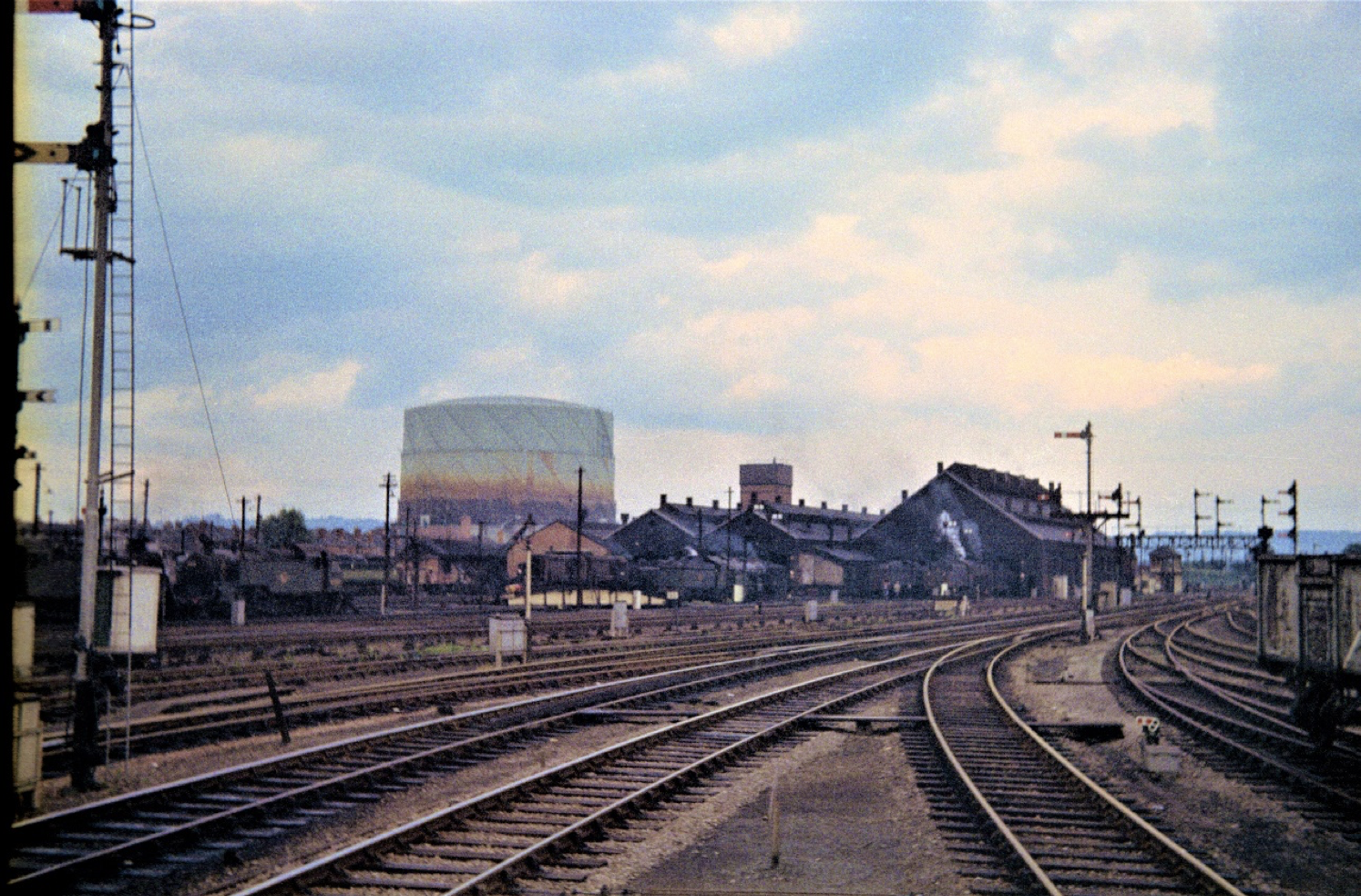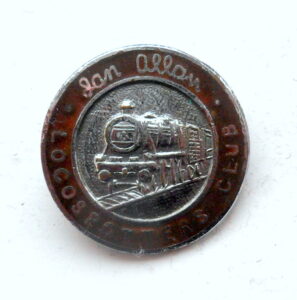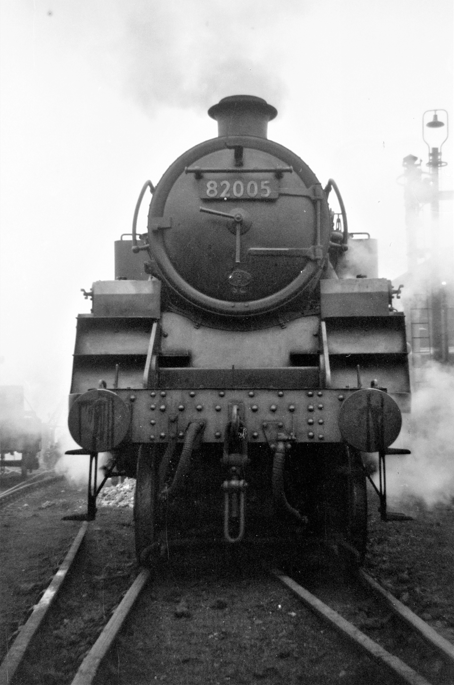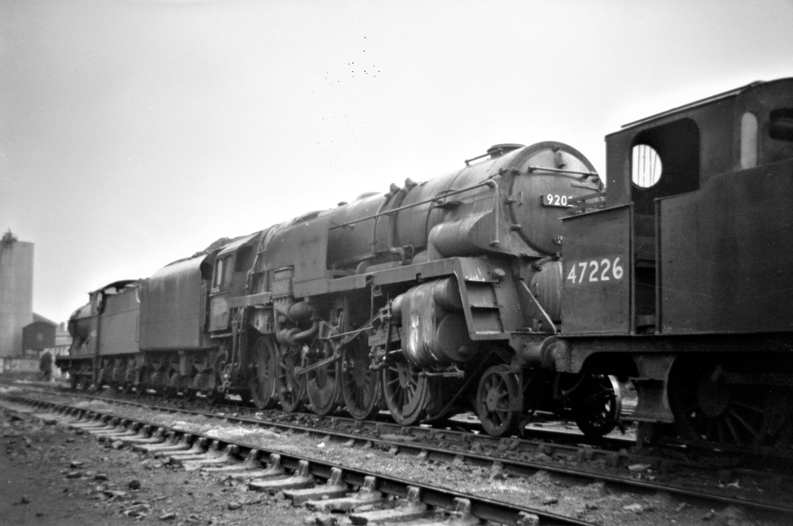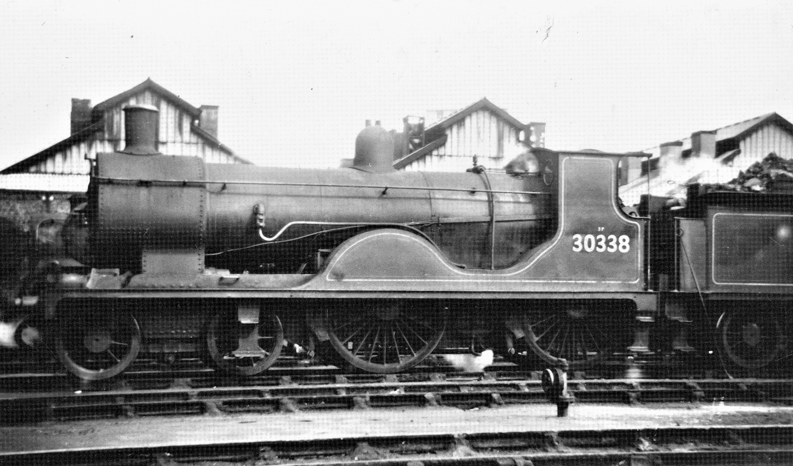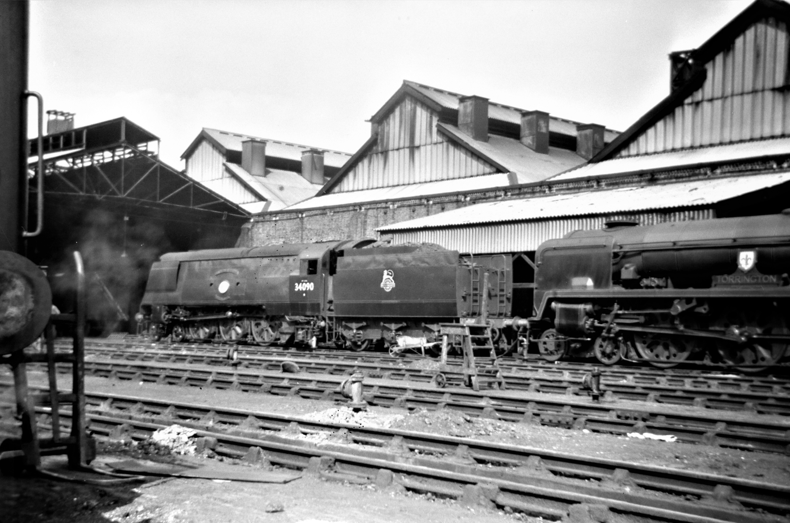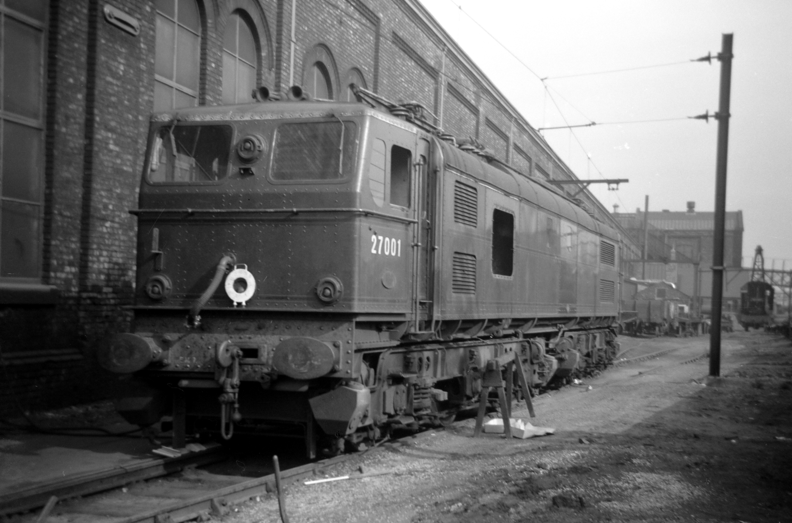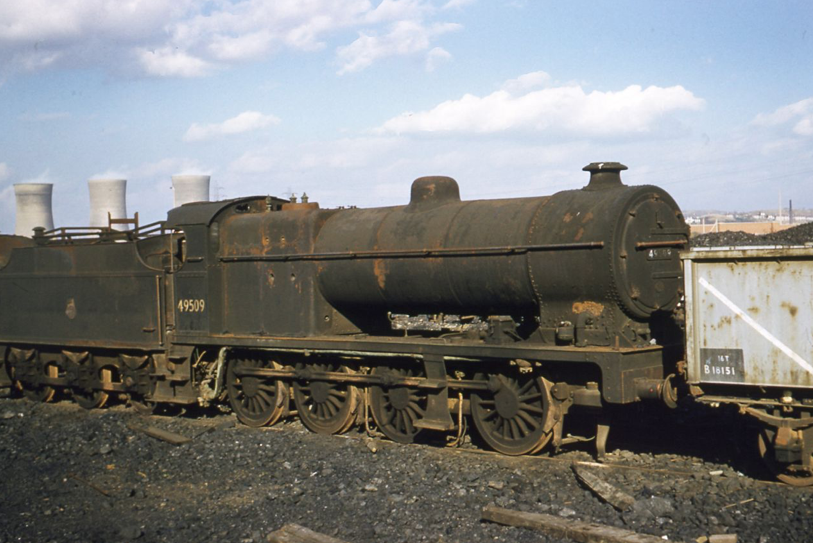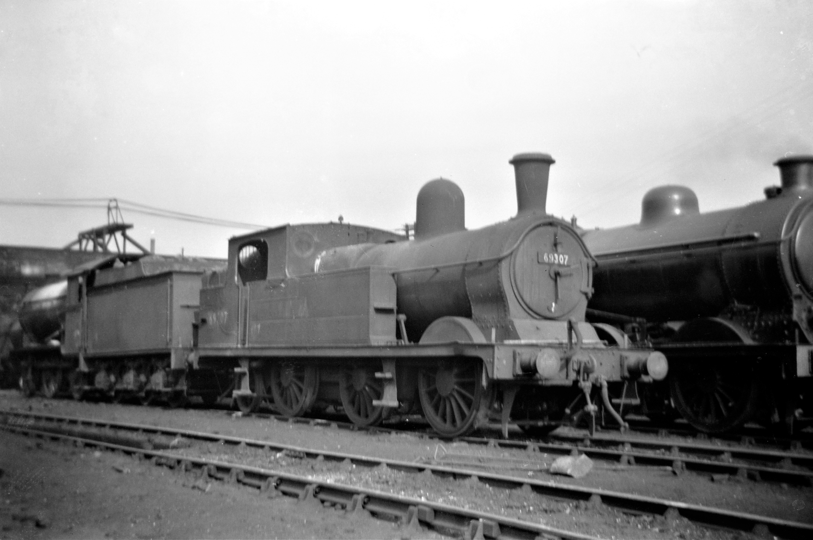Ian Allan Locospotters Club
1957
The Gloucestershire branch of the Ian Allan LSC was initially set up in 1955 and was run by P J (Pete) Sharpe who lived at the Nook, Huntley. He had just finished his National Service. It became an offshoot of the Gloucester City Youth Club in 1956. Pete worked at Fletcher’s in King’s Square, which beside selling sporting guns, had a superb model railway department. He organised trips visiting motive power depots by coach and train from Gloucester and would often join them by cycling to Gloucester from Huntley in the early morning. I started going on these trips from 1957. The emphasis was very much on ‘copping’ numbers in contrast to the special excursions of the Gloucestershire Railway Society visiting branch lines on which some of the older railway enthusiasts went.
Jeff’s Locospotter’s badge
Pete Sharpe organised an early trip on 1 February to South Wales when we visited many sheds in the valleys. These included Aberbeeg, Aberdare, Tredegar, Merthyr, Dowlais Cae Harris (this was a small depot with only 4 locos on shed), Abercynon, and Treherbert. We also visited the small shed at Ferndale near the head of the Rhondda Fach at Maerdy, reached by an amazing hair-pin bend road over the mountains from Aberdare built by unemployed miners during the 1920s depression. ‘Low numbers’ were still in use and up to 1959 I saw over thirty Taff Vale ones and five Rhymney Railway 0-6-2Ts. Their modern counterparts, the ‘5600’ class 0-6-2Ts, were around in abundance. Pete also organised trips on 3 March and 26 May to South Wales sheds in Newport and at Severn Tunnel, Canton, Radyr, Cardiff East Dock and Barry. My WR ABC gave a full list of sheds I visited, including also, Neath N&B, Burry Port, and Duffryn Yard, although I’m not sure when I visited them.
The first mention I have is of an early LSC trip to London sheds on 25 April 1957, visiting Willesden (1A), Camden (1B), Kentish Town (14B), Stratford (30A), Kings Cross (34A) and Old Oak Common (81A).
Then on 6 September 1957 Gloucester LSC travelled by train to Sheffield visiting sheds in the local area, including Grimesthorpe (19A), Canklow (19C), Millhouses (19B), Darnall (41A – still with ‘Directors’, and ‘EM2’ 1500v. dc Electric No. 27000), Mexborough (36B) and Doncaster shed (36A) and works. Locos recorded included ‘A3s’ Nos. 60057 and 60068 (from Carlisle Canal), and the unique 4-6-4, No. 60700, as well as recently completed Standard 2-6-0 No. 76113, ex-works. A Sheffield Corporation coach was used to take us around, and I vividly remember seeing trams running outside one of the sheds (I think it was Millhouses). Our train returning, the 5.15pm from Sheffield arriving in Gloucester at 9.35pm was hauled by ‘Black 5’ No. 44986, with self-weighing tender. I particularly remember the engine losing its footing in Bradway tunnel, and nearly stalling the train.
On 15 September 1957, a coach trip was organised to 1E, 2A/E, 15A/B/D, and 84C/D, but I’m not sure whether I participated. However, I do remember a visit to Woodford Halse in the middle of the Northamptonshire countryside on one trip. It wasn’t until I saw No. 60108, as grimy as anything else in the shed that I realised it was an ‘A3’ Pacific, Gay Crusader, well away from its (then) Doncaster home. That is not to say that ‘A3s’ were unusual on the GC at that time as Leicester Central had an allocation. [I recall an earlier trip in 1955 to a Schoolboy International at Wembley whilst at primary school, seeing No. 60044 Melton charge through Wembley Hill on a Marylebone express]. On another trip (probably on 16 March 1958) further afield to the East Midlands I certainly remember visiting sheds in Nottingham, and going around Colwick, full of ‘WDs’ and ‘O4s’ mostly so dirty that it was difficult to decipher their numbers.
1958
Another interesting Gloucestershire LSC shed-bashing extravaganza by coach occurred on 25 February 1958, via Oxford to Southern sheds (including Eastleigh). Oxford was well known as a place where locos from all four pre-grouping companies could be seen together. I hoped to see a ‘D16’ or ‘B12’ at Oxford as they had been known to work through from Cambridge. ‘B12s’ had recently been made redundant due to the Southend Victoria electrification, but none were present on this occasion. There was however a Standard ‘4’ 2-6-4T from Bletchley (1E), a class mainly employed on local services to Euston, plus some Southern locos working in from beyond Reading. However, owing to a blizzard the A34 across the Berkshire Downs was blocked at Harwell, and the trip was curtailed. Sheds we never reached, but had hoped to visit, included Eastleigh, Bournemouth, Salisbury and Westbury.
On Tuesday 17 April 1958 I made my first recorded trip to London. A visit was made to Stratford shed (30A) and works, with 226 locos recorded here. I also visited Plaistow (33A), which had an allocation of Standard ‘4’ 2-6-4Ts that had taken over some work on the LTS line. I also recorded 15 of the three-cylinder Stanier 2-6-4Ts, which were all based at Shoeburyness (33C). This was the only time I would see locos of this sub-class, as electrification of the LTS line was already programmed, with emus under construction at York. However, Plaistow shed was closed in November 1959. Full electrification of the LTS section did not occur until 18 June 1962 after delays in commissioning new rolling-stock.
With the start of electric services, 33C’s 2-6-4Ts being non-standard were consigned to the scrap heap at Barrow. By the time of our visit the Standard 2-6-4Ts had also ousted the remaining LTS Tilbury 4-4-2Ts: Nos. 41971-4 were reported in store at Durran Hill Carlisle as early as 1955, going to Derby for breaking up by April of that year. A few of the original LTS locos found other employment, but 20 other LTS tanks ended up dumped at Winsford in 1959, along with 14 ‘Duck-Eights’ until they could be cut up at Crewe works. However, one of the original engines, LTS No. 80, was repainted in its original livery in May 1956, and named Thundersley.
Probably the most adventurous LSC trip by coach was to East Anglia, on 21 August 1958. We visited Coalville (15D), the two sheds in Leicester (15C and 15E) and Peterborough (31F and 34E), March (31B) and Cambridge (31A). One ‘K3’, No. 61811 followed us around continuously on the trip! First, we saw it leaving Cambridge whilst we were going around the shed; it passed light engine while we were held at a level crossing en route to March; and amazingly it was on shed when we reached there! In fact, PJ Sharpe’s photo of the loco appeared in the Ian Allan ABC Summer 1959 Combined Volume.
On 16 November 1958, a foggy dull day, we went on a trip to Crewe works, Chester, Wrexham, Shrewsbury, and Oswestry shed (89A) and works. By now I had the box camera my parents had given me as a birthday present at Rhyl that summer. Wrexham and Chester GW sheds had an allocation of Standard ‘3’ 2-6-2Ts and I took photos of Nos. 82005 at Chester GW (6E) and 82020 at Wrexham (84K). A Midland ‘2F’, No. 58171 was in store at Chester LM shed (6A). A key memory was the sight of ‘Scot’ No. 46136 The Border Regiment leaving Chester General bound for Holyhead from the bridge carrying the line into Chester Northgate station (one of my first Scots). Chester Northgate (6D) was an Great Central (ex-ER) shed, although it later became the site of the Crosville bus station. Mold Junction (6B), a typical modern LMS-style straight road shed, seemed to be a windswept place out in the middle of nowhere. Stanier ‘Crabs’ were its forte. At Crewe works I took photos of ‘Jubilee’ No. 45708 Resolution (55C) awaiting attention and ‘Coronation’ Pacific No. 46223 Princess Alice (66A) ex-works. The MPD at Shrewsbury (84G) was effectively two depots on one site (GW and LNW). ‘Counties’ and ‘Manors’ were some of the more interesting types, although 84G did have a few ‘Castles’. Our trip to Oswestry was interesting because it supplied motive power for the Cambrian lines, originally ‘Dukedogs’: ‘Dean Goods’ No. 2538 was also present. We saw quite a few ‘Manors’ there (in fact I cleared them at that stage). The works also contained the narrow-gauge locos from the Welshpool & Llanfair railway, Nos. 822 and 823, in store since the line’s closure in 1956.
Standard ‘3’ 2-6-2T No. 82005 rests on Chester (West) shed on 16 November 1958.
1959
I was still enjoying Gloucestershire LSC trips in 1959. On 22 February, we went on a trip to west Wales, calling at Canton (86C), Neath (87A). Neath (N&B) and Landore (87E). The Swansea sheds, Danygraig (87C) and Swansea East Dock (87D) still contained many dock shunters: these tanks were probably the most exciting / rarest locos seen on this trip. We also visited the former LNW shed in Swansea, Paxton Street (87K), although it was closed not long afterwards on 2 March. It was also good to see the Swansea and Mumbles Railway still operating along the sea front with its double-deck trams, but its closure was imminent, its final day being 5 January 1960.
On Thursday 9 April we took another LSC trip to London by train. A fleet of London Transport RF private hire coaches met us at Paddington (I remember them because of the roof-lights above the luggage racks). We visited many of the main sheds in London: Willesden (1A), 1B (Camden), 14A (Cricklewood, where I photographed Crosti-boilered No. 92027), 14B (Kentish Town), 14D (Neasden), 70A (Nine Elms, where I took photos of Nos. 30338, 34090), 73A (Stewarts Lane) and 73B (Bricklayers Arms – where a photo was taken of ‘C’ class 0-6-0 No. 31102, which unfortunately was double-exposed). Even SR EMUs were copped by the dozen just by looking up at the viaducts outside Stewart’s Lane depot.
Shed-bashing around London was a quite different from lineside spotting – waiting for the trains to pass by – and it became difficult to know what you were seeing as so many of the classes were unknown. It was probably only the passenger locos that registered. These included the SR ‘Schools’, GE ‘Footballers’, and the GN-line ‘Pacifics’. Diesels were just being introduced as the first manifestation of the Modernisation Plan: but it did not matter to us, they were new and exciting.
Later, on 27 September, a lovely sunny day, we went on another Pete Sharpe trip to the Manchester area. I have photos of ‘Super Ds’ at Buxton (9D), Nos. 49509 and 51458 at Agecroft (26B), with the power station as a backdrop, No. 42357 at Edgeley (9B), and No. 27001 at Gorton works. Gorton shed (9G) retained its ex-GC atmosphere where I photographed ‘N5’ 0-6-2T No. 69307 surrounded by other ex-GC locos. I think we also did Newton Heath (26A) and Heaton Mersey (9F), but visits were not allowed at Longsight (9A).
However, not LSC events were solely about collecting engine numbers. One visit I especially remember was to the traffic control office attached to Eastgate station and accessed from Station Road. This was nothing more than a version of the train control system introduced by the Midland Railway by Paget as long ago as 1909 to facilitate the management of traffic. This consisted of a plan of the local network mounted on a board fixed to the wall, rather like the track diagram in a signal box. A series of hand-written tags containing details of each individual train were pinned to the board and moved about as information came in from the various signal-boxes. This enabled traffic movements to be managed in accordance with the wishes of central control rather than leaving decision-making to individual signalmen. It seemed to be an effective if crude system. One other source of information for the young enthusiast could be found from working notices pinned up in the running-office window on platform 2. This reported on special trains, providing up-to-date information on additional services, and late running against booked time which could be considerable. This was particularly so for overnight pigeon specials from Lancashire, which often ran two or three hours late.
The end of this era was probably marked by an extended week’s Scottish extravaganza organised by Pete Sharpe. Rob and another friend came back with well over 2000 ‘cops’. In fact, their Ian Allan ABCs looked as if they were as familiar in Scotland as they were at home. It is significant that they gave up trainspotting after this and moved on to women. However, that is another story!
